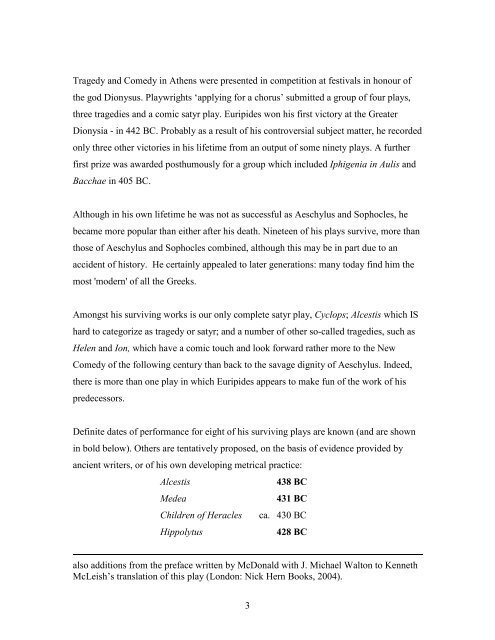1 EURIPIDES' TROJAN WOMEN PREFACE, TRANSLATION, and ...
1 EURIPIDES' TROJAN WOMEN PREFACE, TRANSLATION, and ...
1 EURIPIDES' TROJAN WOMEN PREFACE, TRANSLATION, and ...
You also want an ePaper? Increase the reach of your titles
YUMPU automatically turns print PDFs into web optimized ePapers that Google loves.
Tragedy <strong>and</strong> Comedy in Athens were presented in competition at festivals in honour of<br />
the god Dionysus. Playwrights ‘applying for a chorus’ submitted a group of four plays,<br />
three tragedies <strong>and</strong> a comic satyr play. Euripides won his first victory at the Greater<br />
Dionysia - in 442 BC. Probably as a result of his controversial subject matter, he recorded<br />
only three other victories in his lifetime from an output of some ninety plays. A further<br />
first prize was awarded posthumously for a group which included Iphigenia in Aulis <strong>and</strong><br />
Bacchae in 405 BC.<br />
Although in his own lifetime he was not as successful as Aeschylus <strong>and</strong> Sophocles, he<br />
became more popular than either after his death. Nineteen of his plays survive, more than<br />
those of Aeschylus <strong>and</strong> Sophocles combined, although this may be in part due to an<br />
accident of history. He certainly appealed to later generations: many today find him the<br />
most 'modern' of all the Greeks.<br />
Amongst his surviving works is our only complete satyr play, Cyclops; Alcestis which IS<br />
hard to categorize as tragedy or satyr; <strong>and</strong> a number of other so-called tragedies, such as<br />
Helen <strong>and</strong> Ion, which have a comic touch <strong>and</strong> look forward rather more to the New<br />
Comedy of the following century than back to the savage dignity of Aeschylus. Indeed,<br />
there is more than one play in which Euripides appears to make fun of the work of his<br />
predecessors.<br />
Definite dates of performance for eight of his surviving plays are known (<strong>and</strong> are shown<br />
in bold below). Others are tentatively proposed, on the basis of evidence provided by<br />
ancient writers, or of his own developing metrical practice:<br />
Alcestis<br />
438 BC<br />
Medea<br />
431 BC<br />
Children of Heracles ca. 430 BC<br />
Hippolytus<br />
428 BC<br />
also additions from the preface written by McDonald with J. Michael Walton to Kenneth<br />
McLeish’s translation of this play (London: Nick Hern Books, 2004).<br />
3









